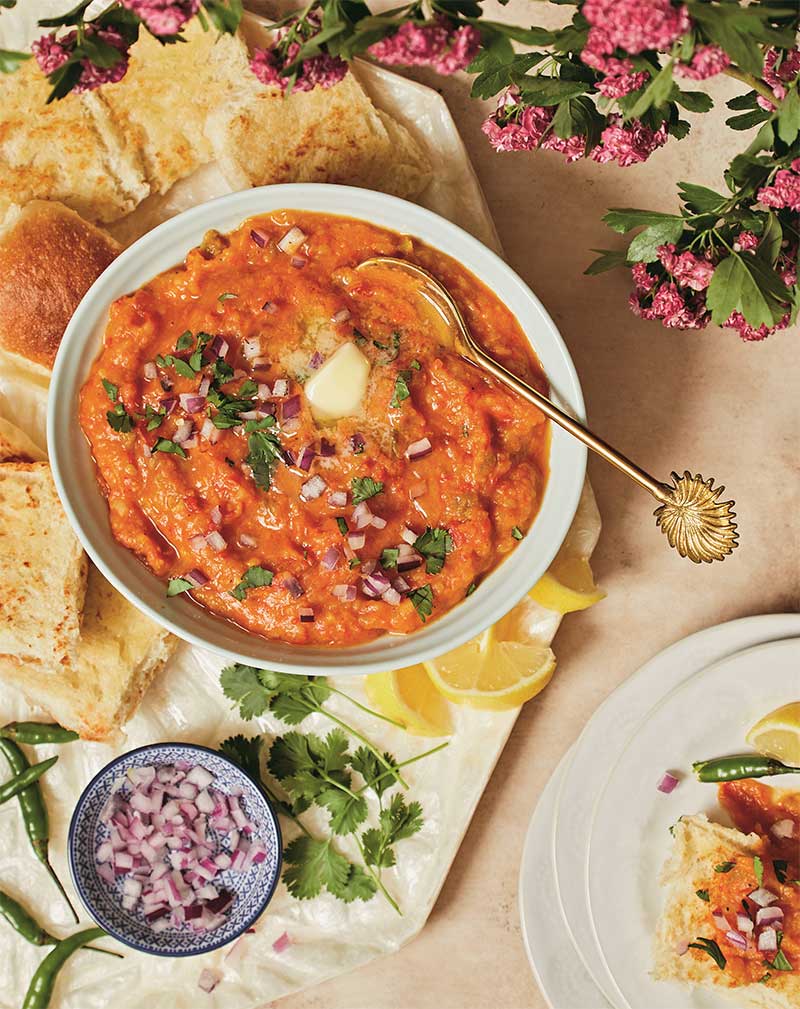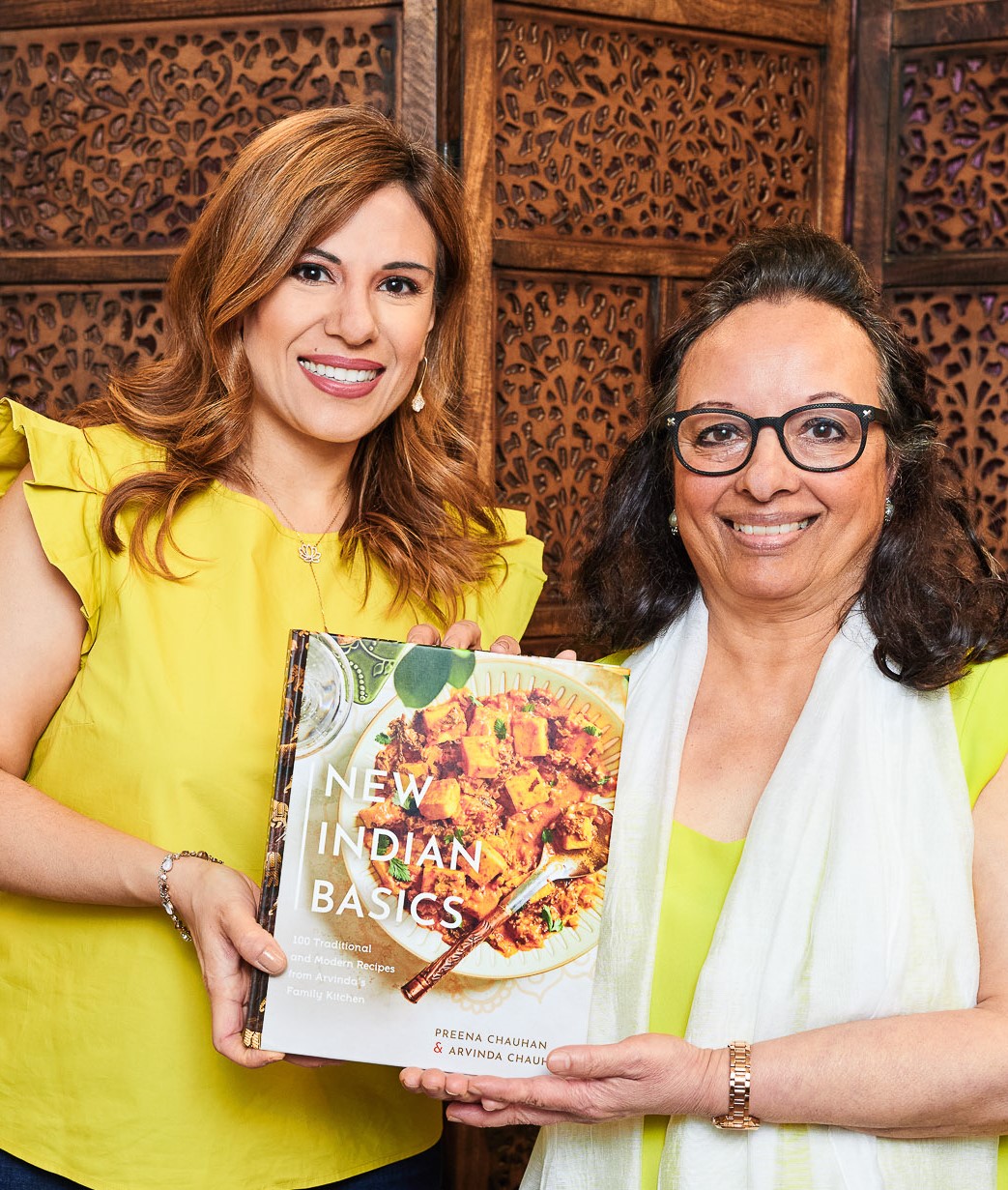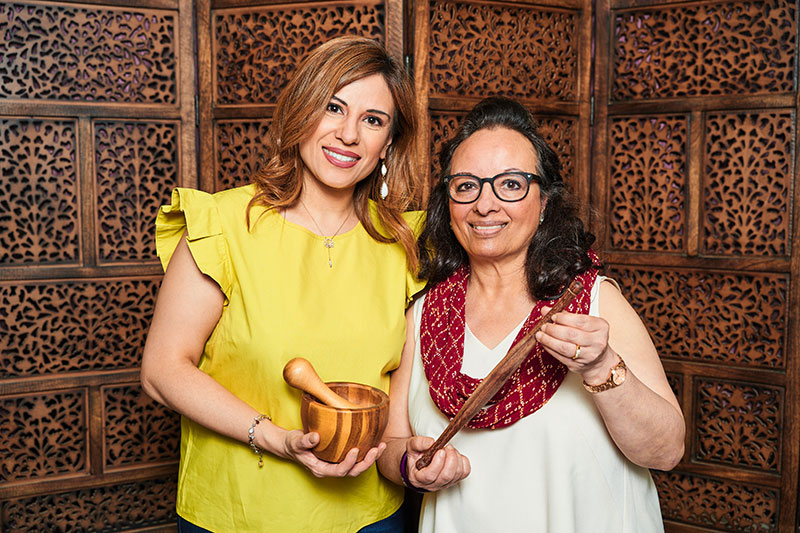

This Mumbai street-food specialty—a mashed vegetable curry (the bhaji) with a ghee-toasted soft bun (pav)—will be love at first bite, guaranteed. The first time I visited Mumbai, on the inbound flight I sat next to a Mumbaiker who was returning home, and we had a great conversation about the food culture of this fascinating city. I jotted down the names of some restaurants to try and the districts to visit as he reeled off a list of delicious things to eat and intriguing places to go. As we got off the plane, my last question to him was this: If I should try just one food from this crazy, bustling city, what would it be? His answer was clear: It must be pav bhaji.
Because of my love for this mouthwatering street food, I teach this dish in our cooking classes, sharing its deliciousness and its origins as a Mumbai specialty and showing how simple it can be to make at home. Garam masala and ghee are musts, and choose a pillowy soft bun to serve with it.
- Step 1: For the bhaji: In a large pot, combine the potatoes, cauliflower, beans, red peppers, water, and 1 teaspoon salt. Be sure there is enough water to cover the vegetables, adding more if necessary. Cook on medium-high heat for 25 minutes or until very soft. Drain any excess water.
- Step 2: In a medium tawa, wok, or non-stick pan on medium-high heat, melt the butter. Add the onions and fry until softened and light golden brown, 5 to 10 minutes. Reduce the heat to medium and add the fresh tomatoes and crushed tomatoes and stir.
- Step 3: Sprinkle in the coriander, cumin, garam masala, remaining 1 teaspoon salt, chili powder, and turmeric. Stir to combine, then add the garlic and ginger pastes. Mix well and cook for a couple of minutes.
- Step 4: Add the cooked vegetables and, using a potato masher or flat utensil, mash the vegetables until smooth. Cook for 10 minutes, until all the ingredients are combined. Add a little water if necessary to make a soft vegetable curry (bhaji). The bhaji shouldn’t be too watery or runny, but neither should it be overly thick and dry. Add salt to taste.
- Step 5: For the pavs: Slice the buns (pavs) in half, leaving one edge attached. Apply a generous amount of butter on each and toast in a frying pan until they are crisp and golden brown.
- Step 6: To serve, spoon hot bhaji into individual bowls. Serve with a toasted pav on the side. Add a pat of butter as a garnish on top, red onions and cilantro to taste, and a lemon wedge on the side. Add a squeeze of lemon to every bite.
Note: Pav bhaji is meant to be eaten with your hands! Break off a piece of the pav and dip it into the bhaji and pop it into your mouth! Choose a pillowy, soft bun or dinner roll to serve with this delicious curry. I like whole wheat, but in Mumbai the bun of choice is white (made from all-purpose flour, known as maida).
Prep Time: 25 minutes
Cook Time: 45 minutes
Yield: serves 4
Bhaji
- 4 medium Russet potatoes, peeled and finely chopped
- ¼ small cauliflower, finely chopped
- 1 cup finely chopped fresh green beans
- 1 red bell pepper, finely chopped
- 1½ cups water, plus extra if necessary
- 2 teaspoons sea salt, divided, plus extra to taste
- 3 tablespoons salted butter
- 1 cup finely chopped onions
- 2 ripe tomatoes, finely chopped
- ½ cup unsalted crushed tomatoes
- 1½ teaspoons coriander powder
- 1 teaspoon cumin powder
- 1 teaspoon Warming Garam Masala
- ½ teaspoon Indian chili powder
- ½ teaspoon turmeric powder
- 1 teaspoon garlic paste
- 1 teaspoon ginger paste
Pavs
- 8 white dinner rolls or soft buns
- ¼ cup salted butter
Garnishes
- Salted butter
- Red onion, finely chopped
- Fresh cilantro, finely chopped
- 4 lemon wedges

Arvinda Chauhan’s passion for Indian cooking grew out necessity when her mother passed away when Arvinda was quite young. This adversity led her to develop a deep love for cooking, providing her a lifetime of culinary experience.
In 1993 Arvinda, joined by her daughter Preena Chauhan, started teaching home cooks and chefs recipes from their ancestral country India, spanning across its diverse regions. The mother-daughter duo focused their classes on spices, the cornerstone of Indian cooking, teaching indispensable flavouring techniques so students can achieve exceptional results when recreating these specialties at home.
Their spice flavouring know-how is shared in their debut cookbook, New Indian Basics — 100 Traditional and Modern Recipes from Arvinda’s Family Kitchen—a 2023 Taste Canada Awards Silver winner—which is a culmination of their culinary wisdom and recipes from their 30 years of teaching together.
Preena, an entrepreneur, co-founded Arvinda’s Indian spice blends with her brother Paresh while pursuing her Master in Environmental Studies degree at York University. They passionately roast, grind and blend spices into time-honoured family masalas so others can enjoy traditional Indian cooking with ease.
As an artist, Arvinda analogizes Indian cooking to painting a picture, where a vast number of elements are brought together to create a work of art. With a masala box in hand, the spices lend a diversity of flavours creating a masterpiece of a curry! Using seasonal Canadian ingredients to inspire a culinary canvas, Arvinda and Preena always add-in beneficially healthy spices, advocating the Ayurvedic philosophy that food, in its most natural state, is a holistic form of medicine.
These featured authors and recipes are presented as part of a collaboration between the Museum and Taste Canada. A project meant to celebrate the vibrant culinary scene in Canada and introduce our upcoming exhibition eat make share: a taste of immigration. This national traveling exhibition will invite you to take a deeper dive into food and immigration. Opening in Halifax, Nova Scotia May 2025.
Presented by


